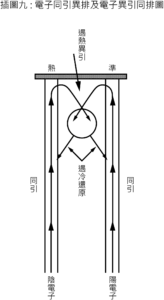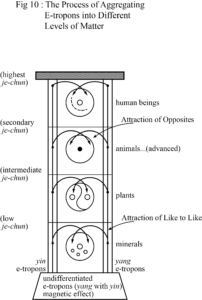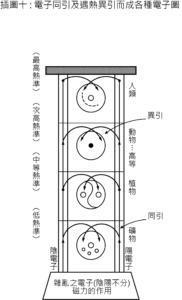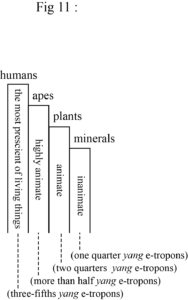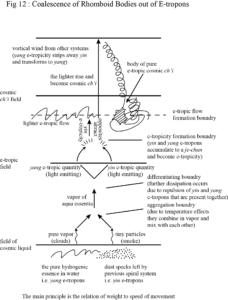第一節 生命之來源
A. The law by which e-tropons aggregate into objects has been discussed in Chapter I above. The origin of life requires two basic constituents of the cosmos to be in balance. That is, only the proper combination of harmonons and e-tropons can give rise to vital force in low-level objects and to life itself in advanced organism. Thus the origin of life and life force must proceed through evolving combinations of e-tropons, to be described below, which lay down a mechanical foundation. Only after these are joined with harmonons can a multiplicity of organic and non-organic objects emerge.
甲、電子構成物體之公律如上部第一章之所論,生命之來源必須宇宙間兩種基本質素之調和,即和子與電子之適切配合,方能產生低級物體之生機及高級物體之生命。故生機及生命之來源,首先必由下述電子組合之演進而奠其機械的基礎,然後配以和子,方能表現出各種有機物及無機物萬殊之狀態也。
1. Origins of the ultimate constituents of matter: “Chapter I” above has already discussed e-tropons as ultimate constituents of matter. But in the stage of primordial chaos, where did e-tropons come from? The answer is that e-tropons, which are matter on the smallest scale and the ultimate constituent of matter, existed in a vast liquid flux during the phase of primordial chaos. This was what remained of the previous spiral harmony system. When the previous spiral system met its eventual destruction and assumed a liquid state, all of its matter disintegrated into tiny particles and spread in the liquid throughout space, or it became hydrogenic essence and floated free above the liquid. These remnant particles are yin e-tropons, and the hydrogenic essence is yang e-tropons. In other words, the formation of a new spiral harmony system depends on the presence of basic substances for gradual growth to happen.
一、物質最終成分之來源—在上部第一章中,已論及物質之最終成分為電子矣。然當混沌之初,此電子究何所自來乎?曰電子者,最微細之物質也,亦物質之最終成分也。故當混沌之初,此種纖維之物質即已存在於洪大之液體中,而為前一個旋和系之遺留物也。當前一個旋和系成為液體狀態而歸於毀滅時,其一切物質均碎為微塵而瀰漫於大空間之液體中,或變為輕氣而浮遊於液體之上。此種遺留之微塵,即係陰電子;而其輕氣即係陽電子也。換言之,一個新旋和系之形成,亦賴此基本質素之遺存而始得逐步生長也。
2. The like-attracts-like law in e-tropons: The movement of yin and yang e-tropons, unlike the directionless oscillation of particles, is attracted by a rule different from that of ordinary electricity. The positive and negative polarities of ordinary electricity follow the principle of “like-repels-like and opposites attract”. However, e-tropons follow the principle of “like-attracts-like and opposites repel”. This is a truth that has not yet been discovered in physics. The fact is, if e-tropons were also governed by the rule of “like repels like”, they could not aggregate to make the units of matter called atoms, and there would be no matter in the universe.
二、電子之同引律—陰陽電子之運行,因其尚未成為一種盲動不已之氣粒子,故其引律亦與普通之電異。在普通電學上之陰陽電為「同排異引」;而電子則為「同引異排」,此為物理學上尚未發現之真理。蓋電子之引律若亦為「同排異引」,便不能湊合而為物質單位之原子,而宇宙間亦無所謂物質矣。
3. The process by which e-tropons combine to become atoms: Since the e-tropons of the universe are governed by the law of like-attracts-like and opposites repel, they can aggregate thereby into various kinds of atoms according to initial, coincidental differences (i.e. quantitative differences in accumulation and assortment of yin and yang e-tropons which fall out of space to a planetary surface). According to the mutually attracting components, they may join into atoms with yin nuclei at their centers (atoms in minerals) or atoms with half yin and half yang nuclei at their centers (atoms in plants) or atoms with yang nuclei at their centers (atoms in advanced animals and mankind). That is, the formation of matter depends on the rule of like-attracts-like among e-tropons, and only in this way do they join together to become atoms.
三、電子結成原子之經過—宇宙間電子之引律既為「同引異排」,故能依其原始時期巧合性之不同(陰陽電子自大空中降落地面而有堆積及配合上之數量的不同),而同性相引湊合而為各種不同之原子。此種原子即依其同引之成分,或組成以陰核為中心之原子(如礦物之原子),或成為陰陽核各半之原子(如植物之原子),或成為以陽核為中心之原子(如高等動物及人類之原子)。蓋物質之形成均依電子之同引律而後始能結合而成為原子也。
4. The law of transformation from e-tropons to electricity: When like e-tropons attract each other, due to increasing temperatures they will gradually reach a certain je-chun. As the e-tropons reach the critical energy, yin and yang e-tropons twist and join together (attraction of opposites) to make electricity (including the positive and negative). This electricity is what we see in the atmosphere as lightning. It is the electricity which we can perceive and do experiments on. As is commonly known, it is governed by the law of like repels like and opposites attract. Thus, yang e-tropons and yin e-tropons must reach a certain level of energy before they can change to electricity and attract their opposites. On the other hand, when that level of je-chun is lost, the electricity goes back to its original form as yin and yang e-tropons, with like attracting like as before.
四、電子化為電之定律—電子同引之時,由於溫度之增加逐漸必到一定之熱準,在電子達到其一定之熱準時,陰陽電子即相互扭合(異引)而成為電(包括陰電與陽電),此種電即為大空中之雷電之電,亦即吾人心目中所感覺而得以實驗之電也,其定律為「同排異引」,如世人所知。是故陽電子與陰電子必至一定之熱準,方可變電而為異引;反之,該電如失去其一定之熱準,即復原而為陰陽電子,仍為同引矣。
5. Relation of substance and energy in the e-troponic composition of matter: The relation of substance in the e-troponic composition of objects depends on the proper je-chun and the proportion of yang e-tropons. If the yin and yang e-tropons composing an object both reach the proper degree of energy and are brought together into atoms, this will be an advanced animal; otherwise it will be a low-level inorganic object. Also, if an object is composed of more yang e-tropons than yin e-tropons (since yang e-tropons are lighter and more mobile), then it will be a static, organized structure of a high level. The relations among these factors are as follows:
五、電子構成物質之質與能的關係—是故電子構成物體之「質的關係」,即為適度之熱準及陽電子之比較。如構成物體之陰陽電子皆達到適度之熱準扭合而成原子,即為高等動物;否則即為低等之無機物。又如構成物體中之陽電子多於陰電子(因陽電子較輕而動力大),即為靜態之高等組織。其相互關係,應如下示:
(1) The attraction of like to like for yang e-tropons is at a higher speed than for yin e-tropons.
⑴陽電子同引之速度較陰電子為速。
(2) If there are more yang e-tropons than yin e-tropons, then they will attract each other and become atoms with yang nuclei at the center. These are the most mobile.
⑵陽電子多於陰電子,則同引而成以陽核為中心之原子,動能最大。
(3) If the numbers of yin and yang e-tropons are equal, like will attract like to make atoms with half-yang, half-yin nuclei. Mobility is second only to Number 2.
⑶陰陽電子數量相等,則同引而成陰陽核各半之原子,動能次之。
(4) When yin e-tropons outnumber yang e-tropons, like will attract like to make atoms having yin nuclei at their centers. These are the least mobile. The above is the basic relation of substance and energy in the e-troponic composition of atoms of matter.
⑷陰電子多於陽電子,則同引而成為以陰核為中心之原子,動能最弱。
Up to the present, even advanced hypotheses of atomic chemistry have not elucidated these things.
以上為電子構成萬物原子之「質與能的基本關係」,截至目前為止,最進步之原子化學的假定亦尚未能加以闡明。
6. Relation of quantity in the e-troponic composition of matter: In the law of e-troponic composition of matter, aside from the relation of substance and energy described above, there is also the relation of quantity. The relation of substance determines the matter’s level of mobility, while the relation of quantity distinguishes the degree of fineness in matter. The e-tropons contained in matter, due to impact of like attracting like, have mechanical, Brownian movement. Only when joined with harmonons do they have organic properties. Here are examples:
六、電子構成物質之量的關係—電子構成物質之公律,除上述質能的關係外,尚有量的關係。「質的關係」決定物質動能之高下的分別;而「量的關係」則為物質精粗的分別。物質中所包含之電子,因其不斷同引相磨,故有一種機械的蠕動力,然後配合以和子,始具有機體之作用,舉例如下:
(1) E-tropons in the human body are hypothetically ten times more numerous than in apes.
(2) E-tropons in apes are hypothetically twice as numerous as in advanced plants.
(3) E-tropons in low-grade plants are hypothetically twice as numerous as in rocks.
⑴假定人類身體之電子較猿類多十倍。
⑵假定猿類之電子較高等植物多一倍。
⑶假定低等植物之電子較石類多一倍。
By virtue of e-tropon quantity, mankind comes to be the most highly realized life-form; apes come next; but plants have only the functions of flowering and bearing fruit. As for minerals, they may have life force, but mankind has not yet observed it. (In truth, rocks have growth, but humans have not noticed and therefore judge them to be inorganic.)
由其電子量之關係自能形成人為萬物之靈,猿次之,而植物則僅有生葉開花結果之功能。至於礦物,則雖有生機而人類未加覺察(事實上即岩石亦有伸長,但人類未能注意及之,故斷為無機物耳)。
Combining the above relations of substance, energy and quantity in the e-troponic composition of matter, the following explanatory diagrams can be drawn:
綜合上述電子之質能與數量之關係,可作圖表說明如下:
(1) The attraction of e-tropons that form the atoms of human beings, animals, plants and minerals are shown in Figure 10.
⑴電子構成人類、動、植、礦各物原子之引律(如插圖十)。
(2) The quantity relations of e-tropons distinguishing human beings, animals, plants and minerals are as in Figure 11.
⑵電子構成人類、動、植、礦物之質量關係分別(如插圖十一)。
(Note: For example, the fact that a magnet applied to a pile of iron and copper filings will attract the iron filings and not the copper filings demonstrates attraction of like by like.)
(註:譬如一堆銅鐵末子以吸鐵石吸引,必吸鐵末子不吸銅末子,證明同引異排。)
(3) Thus, when ultra-small e-tropons join to make a spiral harmony system, the entire process of transformation and evolution should be as in Figure 12.
⑶是故由最微細之電子而結成一個新的旋和系,其變化演進之過程,應如插圖十二。
(Note: The main principle is the relation of weight to speed of movement)
(註:此表總原則為輕重快慢關係。)
B. Attraction of harmonons to objects: Since e-tropons constitute the various animal, plant and mineral things of this world, they thereby have physical form as objects with static e-tropic charge, and possess the property of attracting opposite e-tropic bodies. Thus harmonons are absorbed by various objects according to the attraction of opposites in e-tropicity, and life in the objects is initiated.
乙、和子引合物體之公律—世間各種動植礦物既由電子構成,故即具形而成為靜電單位之物體,具有吸引異性電體之功能,是以和子得按電學上異引之關係而被分別吸入各種物體之中而開展其生命。
Harmonons are particles containing yang e-tropicity which pervade outer space and our own world. Harmonons exist in great quantities where there is no boundary to their passage. Wherever there is matter with yin e-tropicity, there will be harmonons drifting in the vicinity, and as the two kinds of e-tropicity meet, the harmonons will be absorbed. Once they are present, minerals will have life force and animals will have life. They are what governs these objects, by the following laws:
和子為一種含有陽電之質素,瀰漫於大空之間及世間各處,凡通風之處即有和子之存在,而其數量亦不可勝計。是以凡有陰電體物質之處即有和子飄遊於其附近,兩電相值即行引入。礦植物得之即有生機,動物得之即有生命,並為此物體之主宰,其公律如下:
1. In minerals, assume that there is one harmonon for each 4.32 square inches of area. The attraction will be as follows:
一、在礦物中,假定每三平方寸面積之內即有一個和子,其引律如下:
(1) The uppermost portion of minerals can absorb harmonons within one cubic meter; the middle layer can absorb harmonons within a volume of 10.38 cubic inches; the lowest layer can absorb harmonons within a volume of 2.07 cubic inches.
⑴礦物之上部可引入空間一立方公尺以內之和子,其中間部分可引入約六立方寸以內之和子,其下層則可引入約一.二立方寸內之和子。
(2) For any harmonons absorbed into an organism, except in mankind, the direction will be downward.
⑵凡和子被引入物體,除人類以外,皆垂直而下。
2. In plants, whenever a seed is sprouting (i.e. its e-tropons are in a ferment), then its atoms will absorb a harmonon. Attraction is possible for any harmonon within a volume of one thousand cubic feet.
二、在植物中,每當其種子之原子萌芽時(即電子發酵),即引入一和子,其引律為在該種子之一立方丈以內之和子,皆有被其引入之可能。
3. When an ape is first born, it can attract harmonons from anywhere within a volume of two thousand cubic feet.
三、猿類當初生時,可引入二立方丈以內之和子。
4. When a human being is born, it can attract harmonons from anywhere within a volume of three thousand cubic feet.
四、人類初生時,可引入三立方丈以內之和子。
(The first harmonon absorbed into the object takes predominance.)
(以上和子之被引入物體之中,皆以先入者為主)
All phenomena of life in the world arise naturally from this attraction, until such time as the objects where they rest is destroyed (at which time they are expelled outside). Only then does it drift off as free-floating harmonon.
世間一切生命之現象,即係由此引律而自然發生,直至其所憑藉之物體歸於毀滅(即將其排擠於外時),始得復其自由而重為飄飄渺渺之自由和子焉。
C. Birth and death of humans: The birth and death of human beings is governed by this law of attraction. An infant coming from its mother’s womb already possesses the physiological characteristics that make it male or female, strong or weak. All of these are based on the different combinations of e-tropons passed down hereditarily. While still in the mother’s womb, yin and yang e-tropons within the body are attracted by their own kind. If yang e-tropons are relatively numerous above the navel, they will cause the yang e-tropons below the navel to rise upward. As a result, e-tropons below the navel will have higher numbers of the yin type, making the physical characteristics of a female infant. Conversely, if there are more yang e-tropons below the navel, yang e-tropons from the upper body will be drawn down, making the physical characteristics of a male infant. This makes the difference between male and female. At any rate the fetus at this time is charged with static e-tropicity (yin e-tropicity), and so it can attract harmonons having opposite yang e-tropicity.
丙、人類之生死—是故人類之生死即受此律之支配,當其初為嬰兒而出母胎時,即已具備一切生理之形質,有男有女,有強有弱,均係基於其所自遺傳而來之電子組成關係。當其尚在母胎中時,其軀體內之陰陽兩種電子各自同引,如該嬰臍部以上之陽電子較多,即將其臍部以下之陽電子儘量提上,結果其臍部以下之電子,多為陰電子,即成為女嬰之生理構造,反之,如該嬰臍下之陽電子較多,而將上部之陽電子提下,即成為男嬰之生理構造,故有男女之別,惟此時該嬰尚是一個靜電體(陰電),故能異引陽電性之和子也。
When the infant first issues from its mother’s womb, any nearby harmonon within a volume of three thousand cubic feet is absorbed into the cerebrum (the first to enter predominates). Later, this absorbed harmonon becomes a regulating force which has power over the person. It directs his cerebrum until the person dies.
嬰兒初出母胎之時,即將其附近廣三立方丈垂直以內之和子引入其大腦之中(以先入者為主),而後該被引入之和子遂成為該人之主宰而行使其權威,指揮其大腦,直至該人死亡之時始止。
When a person is young, his e-tropon-harmonon combination is in relative balance; mind and matter are in harmony. In this way, the person is regulated by his harmonon (the harmonon directing the cerebrum and the cerebrum directing the physical body). In maturity and after, the person’s demand on his e-tropons becomes increasingly great. Despite daily tonics to strengthen this person, there is too much attrition. By the time old age comes, the body is filled with yin e-tropons. Stasis overcomes dynamism; matter overcomes mind. There is no longer a place for the harmonon, and it is pushed outside of the bodily shell, composed of a statically charged concatenation of e-tropons (or, when suffering great pain or shock, the harmonon flies away immediately). This is the terminus of life.
人類當幼時,電子與和子之配合較為平衡,心物協調,故能聽命於和子之節制(和子指揮大腦,大腦指揮生理),及壯而後該人對於電子之要求與日增加,雖日常營養補充不已,但因消耗過多,至老年時,由於人體中均被陰電子充滿,靜勝於動,物勝於心,和子再無容身之地,遂被排出由電子所湊成的靜電物體軀殼之外(或受大痛苦,大刺激時其和子立即飛去),是即為生命之結束。
The harmonon in a human being, because it has remained a long time in the human body, must in fact take on some yin e-tropicity, just as an iron strip placed near a magnet will be magnetized. Its yang polarity has grown too weak to come under attraction by the yin e-tropicity of the object (that is, the dead body). Instead, this is a case of like repels like, so once separated from the body it cannot be absorbed, and it becomes a free-floating harmonon.
人類之和子因在人類之軀體中居處較久,事實上必染有陰電性;如同鐵片磁石共處而被磁化,其陽性已減弱不足與其本體(即死亡之軀殼)之陰電相引,而成為同性相排,故一經脫離其軀殼,便不能再被引入,而成為飄渺之自由和子去矣。
This description of the birth and death of human beings is offered as an example. The same is true for life and death among animals, plants and minerals. For instance, the harmonon of a ten-foot tree is located in the trunk some 6 to 10.8 inches from the ground, a place analogous to the cerebrum in human beings.
上述人類之生死,不過舉例而已,他如動植礦物等之生滅,亦莫不然也。如一丈高之樹木中之和子係居於其樹根離地五寸至九寸之處,該處即等於人類之大腦。
D. Randomness of life: Based on the above discussion, in this universe the world is pieced together out of harmonons and e-tropons. E-tropons compelled by attraction of like-to-like combine into matter and become objects with static yin e-tropicity. As for harmonons, they drift about in cosmic space and are compelled by attraction of opposites. They go in and out of objects, passing through life and death without end. In all cases they are controlled by electrical attraction. Thus the fate of harmonons is truly sad, for they are without power to choose for themselves. When they are drifting over the earth, they are liable to be trapped anytime, anywhere. For them there are thorny traps everywhere. In a careless moment they are absorbed, and then they cannot escape until the dissolution of that object. Thus harmonons that were in minerals may be absorbed into a human infant, and human harmonons may be absorbed into animals or plants. Consider a human harmonon that eventually is absorbed into a rock or plant made of low-grade e-tropon components. How would it feel? Thinking about it makes one shiver! In fact, for as long as the world has existed, all the harmonons confined in high mountains and forests have been in what Buddhists call the Avidya Hell [The Hell of Endless Suffering]. Only when things in decline are sifted out by the cosmos, when mountains are levelled and rocks are crumbled, can there be a way out. It is a lucky thing to be human, but it is as transitory as an epiphyllum flower.
丁、生命偶然論—基上所論,此宇宙之中便為無量數之和子與電子所湊成之世界。電子由於同引律之支配而結成物質,成為陰靜之電體;和子則飄遊於宇宙之空間而受異引律之支配,出入於物質之中,生生死死,永無已時,蓋一切皆受電學上之引力支配故也。是以和子之命運實屬悲慘,了無自擇之力,當其飄渺於地面之時,隨時隨地均有陷阱,可謂荊棘遍地,偶一不慎,即被吸入,一經吸入,即非俟該物毀滅期至,不能脫離。是以礦物中之和子可以被嬰兒吸入,而人類之和子有時亦可以被動植礦物吸入。試思以人類之和子一旦如被吸入低級電子成分所湊成之石塊或草木之中,則其感覺當如何?誠可謂不寒而慄矣!蓋自有天地以來,所有一切高山森林中被拘禁之和子,即佛說所謂無間地獄也,非俟天然淘汰,山崩石爛之時,當永無出期。幸而為人,亦不過曇花一現而已。
How can we characterize this theory? It is a theory of the randomness of life, or reincarnation by natural laws. It is also a pessimistic doctrine that all composite things are transitory. If this is truly the ultimate of human life, it can be thought of as meaningless in terms of value. Thus it is necessary to make the following argument as a further explanation. Only this is sufficient to let us see the true character of life.
此論何論?曰生命之偶然論也,自然律之輪迴論也,亦諸行無常之悲觀論也。人生之究竟果若如是,則生命之價值亦可謂了無意義矣。故又必有下說以補充說明之,始足以見生命之真相也。
E. The theory of life causality: In this universe, everything is controlled by laws of nature. As Lao Tzu (老子) says, “The Tao follows what is natural”. Not even life can escape to do as it pleases. This much has been made plain above. But life is also a matter of harmonons, of spirit. Spirit, which is harmonon, is not some sort of ethereal vapor. That it too is an assemblage of advanced reactive elements has already been touched on above. Since harmonons can retain awareness and wisdom, their life is naturally able to continue developing. It is even sufficient to overcome control by natural laws and find a carefree existence beyond their constraint. Such harmonons which in themselves possess ability to strive are “deities” . Deity is an inclusive term for advanced harmonons which can remain uncontrolled by natural laws. Their attainments and methods of striving and what they gain are at various levels. All reach attainments according to their own level of striving. In brief, those that escape constraint by e-tropons and attain to the realm of high-grade true yang (partaking of the nature of raydon) are the ones possess of greatest capability. If not at this highest stage, they belong to progressively lower degrees of divinity as the quantitative charge of e-tropons increases. Thus the Buddha speaks of the three realms of desire, form, and formlessness in the great world of all orders of magnitude. What is termed “form” is e-tropons. E-tropons are the source of matter, and the greater their quantity the more they coalesce and sink downward; the smaller their quantity, the lighter and more risible are the harmonons. With the added strengthening effect of raydon substance, they can transcend the three realms and get outside of the constraints of the five phases. Also, they can come and go unhindered, making them what is called tathagata or “thus-come ones”. Then there is the Lord, who possesses the most sublime and pure raydon, and is not only able to drive all phenomena with raydon force, but also confers spirit on living things.
戊、生命因果論—此宇宙之間,一切均受自然律之支配,即生命亦不能逍遙於「道法自然」之外,固已明言之矣。然生命者,和子也,亦性靈也。和子與性靈之非屬虛無飄渺之氣體,而亦為一種高級化學原素之組合,亦經論及之矣。和子既能保持其知覺及智慧,則和子之生命自有其繼續發展之能力,甚至於足以凌駕自然律之支配而逍遙於其拘束之外。此種具有自我奮鬥能力之和子,即為「神」。神者,具有不受自然律支配能力之高級和子之總稱也,其奮鬥之方法及成效,亦有其不同之等級,皆依其自我奮鬥之程度而達到之。要之,凡能免除其電子之拘束而達到高級真陽(係屬鐳性)之境界者,即具有最大之能力;反之,即為依次遞減其電子量之電體的神類。故佛說此三千大千世界中有欲界、色界及無色界三界。所謂「色」即電子也。電子為物質之根源,電子量越多,便越凝聚而下沉;電子量越少,便越清輕而上升,又加以鐳質之作用以增強之,故能超出三界外,不在五行中,亦能隨心所欲來去自如,所謂「如來」是也。至於 上帝,則為具有最精華之純鐳質,不但能以鐳力驅使一切現象,並能賦予生物之性靈。
The One whom we call Lord is master of all spirits in the cosmos. The Lord possesses awesome divine power and can harmonize the laws of the cosmos in ways that go beyond ordinary physics and electrical science (see below). But human beings cannot yet perceive this with their eyes. Since the Lord possesses mastery over spiritual beings throughout the universe, there are of course inherent laws and principles in the non-physical world. What is more, all harmonons, in their incarnation and transcendence, have a coordinated relation between causality and the laws of nature.
夫 上帝者,全宇宙性靈之主宰也,具備大威神力,對於宇宙規律之調和則是超乎一般物理與電子科學之外(詳後),惟人類未能目睹之耳。 上帝既具有主宰全宇宙間性靈之能力,則無形之中自亦有其法度,有其律令,而一切和子之輪迴超脫亦均有其因果與自然兩元之配合關係。
Life at its source is bestowed by Lord of the Universe. It has both random and causal aspects. The causal aspect is active; the random aspect is passive. The active aspect has ability to utilize laws of nature to attain its aims; the passive can only accept control by natural law and go through unending reincarnations.
生命之來源皆是得自 宇宙主宰之賦予,有偶然的,亦有因果的。因果的為主動的;偶然的為被動的。主動的具有運用自然律之條件而達其目的之能力;被動者則唯有接受自然律之支配而輪迴不已。
As for how can harmonons transcend intimidation by natural laws, this is determined within the sphere of human life, not outside of it. Seeking to remedy things after death would be too late. Hence the following section was written to address this.
至於和子之如何始得以超出自然律之威脅,則操在人生之中,而不在人生之外也。若求死後再為補救則已遲矣,故又為下節以論之。


